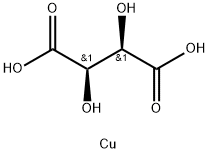bluish green crystal(s) [STR93]
Copper(II) Tartrate can be useful in gas-induced formation of Cu nanoparticle as catalyst for high-purity straight and helical carbon nanofibers.
A green to blue odorless powder. Insoluble in water. The primary hazard is the threat to the environment. Immediate steps should be taken to limit its spread to the environment. Cupric tartrate is noncombustible. Used for electroplating metals.
Acidic salts, such as Cupric tartrate , are generally soluble in water. The resulting solutions contain moderate concentrations of hydrogen ions and have pH's of less than 7.0. They react as acids to neutralize bases. These neutralizations generate heat, but less or far less than is generated by neutralization of inorganic acids, inorganic oxoacids, and carboxylic acid. They usually do not react as either oxidizing agents or reducing agents but such behavior is not impossible. Many of these compounds catalyze organic reactions.
INHALATION: Inhalation of dust may cause nasal congestion. EYES: May cause conjunctivitis and edema of eyelids. SKIN: May irritate skin. INGESTION: Vomiting is caused by local irritant and astringent action of ionic copper on stomach and bowel.



